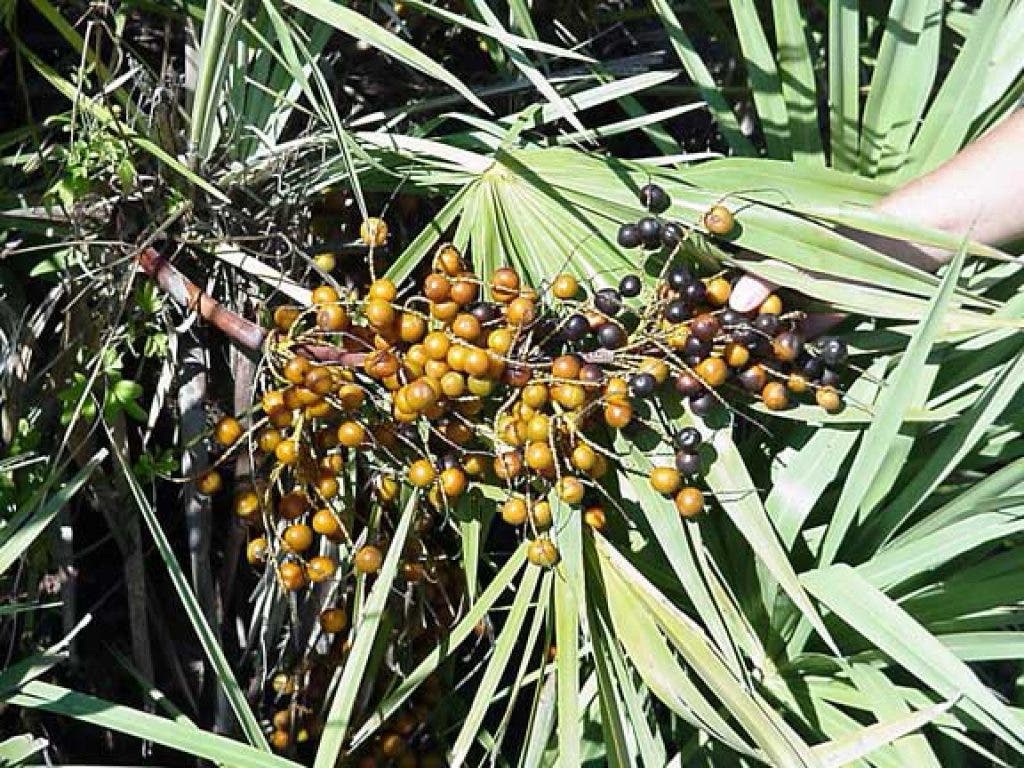
By Prof. Raphael Nyarkotey Obu
Institute of Medicine (US) and National Research Council (US) Committee on the Framework for Evaluating the Safety of Dietary Supplements. Dietary Supplements(2005) reports that Saw palmetto, or Serenoa repens, is a dwarf palm tree native to the southeast regions of North America and especially abundant in Florida, Georgia, Cuba, and the Bahamas.
It grows in sandy soil and gets its name from the sharp, saw-like teeth on the stalks that attach the tree’s leaves to its stem. The saw palmetto tree produces dark berries that contain a large seed.
The saw palmetto fruit has long been used by Native Americans for its nutritional, diuretic, sedative, aphrodisiac, and cough-reducing properties.
De Monte et al.(2014) study found that saw palmetto contains75–90% fats depending on the extraction method. They typically provide higher amounts of beneficial plant compounds like vitamin E and other antioxidants compared to raw fruit.
Its active ingredients include fatty acids, plant sterols,and flavonoids.
The berries also contain high molecular weight polysaccharides (sugars), which may reduce inflammation and strengthen the immune system — thus adding immune system booster to the list of saw palmetto benefits.
The most important factor about Serenoa repens is that it’s been shown to slow the production of the enzyme 5-alpha reductase, so taking it is a strong step to improve prostate health. This enzyme converts the male hormone testosterone into dihydrotestosterone (DHT) — a sex steroid and androgen hormone.
DHT is important because it plays a role in male development, it also contributes to many common health issues in men, such as loss of libido, an enlarged prostate, and hair loss. By taking Serenoa repens supplements or using the extract of this beneficial plant, you inhibit the production of this hormone and help avoid these issues that are seen in middle-aged and older males, including enlargement of the prostate and BPH symptoms.
Saw palmetto berries may also help relieve chronic pain and migraines and reserve hair loss, in addition to other saw palmetto benefits.
Today, saw palmetto supplements are some of the most commonly consumed supplements by men with prostate cancer and benign prostatic hyperplasia (BPH) thanks to the numerous saw palmetto benefits. In fact, by 2032, over $309 million in saw palmetto supplements is expected to be sold in the U.S., says Persistence Market Research.
In this article, I examine the science of saw palmetto.
Prostate health and urinary function
Several studies have looked at saw palmetto’s effect on LUTS — with mixed results.
For instance( Wilt et al. 2000; Champault et al. 1984; Bertacciniet al. 2012; Ryu et al. 2015; Morgia et al. 2014) found that saw palmetto could help increase urine flow and reduce nighttime urination in men with BPH — both when used alone or in combination with traditional drug therapy.
Another study by Tacklind et al. (2012) Cochrane review — the highest standard in evidence-based healthcare — concluded that saw palmetto provides little improvement in LUTS.
Two other studies( Novara et al. 2016; Vela-Navarrete et al. 2018) found that a daily dose of 320 mg of Permixon — a specific saw palmetto extract — was more effective than a placebo at improving urine flow and reducing nighttime urination.
Also, another human study by Suter et al.(2013) analyzed 82 patients in an eight-week trial. The patients took one capsule of 320 milligrams of saw palmetto extract daily.
At the end of the treatment, the International Prostate Symptom Score was reduced from 14.4 ± 4.7 to 6.9 ± 5.2. Investigators’ and patients’ assessments confirmed the good efficacy, and treatment was very well-tolerated and accepted by the patients.
A recent study by Kwon Y(2019) found that saw palmetto extract had therapeutic potential. However, Saw palmetto products needed to be standardized for consistent efficacy in both the prevention and treatment of BPH.
Healthline notes that the effects may vary based on the strength of the individual formulation.
Reduces Risk of Prostate Cancer
A systematic literature review of 11 studies( Penugonda and Lindshield. 2013) found that saw palmetto supplements as one of the five commonly used forms of alternative medicine by men with prostate cancer.
Serenoa repens supplements work as 5-alpha reductase inhibitors — meaning they slow down the conversion of testosterone to DHT by blocking the enzyme and preventing its formation. According to research, DHT is responsible for prostate enlargement, which may be a cause of prostate cancer.
According to Cancer.org, though the science is still unclear on this matter, studies on two 5-alpha reductase inhibitor prescriptions, Finasteride (Proscar) and Dutasteride (Avodart) found that men taking either drug were less likely to develop prostate cancer after several years than men getting an inactive placebo. The problem lies in the side effects of these medications — they can cause sexual side effects, such as lowered sexual desire and impotence.
Saw palmetto, on the other hand, can also inhibit DHT and help with urinary problems from BPH, such as trouble urinating and leaking urine — plus it regulates your testosterone levels, helps with libido, and works as a natural remedy for impotence.
For instance, Yang et al.(2007) study found that saw palmetto inhibits the growth of prostatic cancer cells and may destroy dangerous cells. This study found that saw palmetto induced growth arrest of prostate cancer LNCaP, DU145, and PC3 cells and down-regulated DHT, the hormone that leads to prostate enlargement.
Another interesting note about saw palmetto is the research that has been done to measure its effect on post-surgery recovery time. Prostate surgery (known as transurethral resection of the prostate or TURP) can require a lengthy recovery period, but research shows that taking 320 milligrams of saw palmetto daily for two months before prostate surgery can reduce the time spent in surgery.
It also helps with blood loss, the development of problems during surgery, and the total time spent in the hospital.
Decrease male pattern baldness
Saw palmetto may help prevent androgenic alopecia — a type of hair loss also known as male and female pattern baldness in men and women, respectively.
Some studies( Ustuner ET. 2013; MedlinePlus, 2023) report that saw palmetto works by blocking the enzyme that converts testosterone to dihydrotestosterone (DHT), an androgen-type hormone believed to cause this form of hair loss.
MedlinePlus, (2023) further asserts that the higher levels of androgen hormones like DHT are thought to shorten the hair growth cycle and lead to the growth of shorter and thinner strands of hair.
For instance, one small study by Prager et al.(2002) reports that a daily 200-mg dose of saw palmetto — taken with another beneficial plant compound known as beta-sitosterol — reduced hair loss in 60% of men with androgenic alopecia compared to a placebo.
In Rossi et al.(2012) 2-year study, men with male pattern baldness were given 320 mg of saw palmetto per day or finasteride, a conventional hair loss medication. After the study period, about one-third of those given saw palmetto reported an increase in hair growth. That said, saw palmetto was only half as effective as the conventional medication.
In a recent study, Evron et al.(2020) review of evidence published in the Cochrane database, PubMed and Google Scholar found that Serenoa repens extract resulted in improvement in overall hair quality, total hair count, and hair density among alopecia patients. Reports also show that saw palmetto was well-tolerated and not associated with serious adverse events.
A small study also reports a small increase in hair count in about half of the men treated with a saw palmetto hair lotion. However, this lotion also contained other active ingredients, making it difficult to isolate the effect of saw palmetto.
Decrease inflammation
One study in mice by Bernichtein et al.(2015) with enlarged prostates observed that saw palmetto extract decreased swelling and several markers of inflammation, including interleukin 6 (IL-6).
Another study in rats with BPH found that saw palmetto decreased inflammation and improved antioxidant status ( Colado-Velázquez J et al. 2015).
Saw palmetto, how it works
The active compounds in saw palmetto help to block the activity of 5-alpha reductase, an enzyme responsible for converting testosterone to DHT.
A recent study by (Nassar and Leslie, 2023) found that it helps to maintain testosterone levels as you get older, which may lead to improvements in body composition, libido, and mood.
A previous study by Kim et al. (2018) also asserts that because DHT plays a role in the enlargement of the prostate gland, decreasing your levels of DHT by using saw palmetto may also improve prostate health and BPH.
Another by Chen et al.(2019) also found that saw palmetto could support hair health, as DHT regulates hair growth and may contribute to hair loss and balding.
We still do not know whether saw palmetto is effective for any of these conditions.
Other benefits
One test-tube study by Latil et al.(2012) found that Permixon – a specific formulation of saw palmetto – could reduce markers of inflammation in prostate cells. This notwithstanding, Sirab et al.( 2013) wonder if saw palmetto supplements have the same effect.
Permixon may also protect libido and fertility in men. Conventional drug therapy for BPH and LUTS has been shown to negatively impact sexual function in men.
A review of 12 randomized controlled studies — the gold standard in nutrition research — compared Permixon with conventional drug therapy as a treatment for BPH and LUTS.
Novara et al.(2016) found that though conventional drugs alsoproduced negative side effects on male sexual function, the saw palmetto supplement led to smaller drops in libido and lower impotence compared to the conventional drug treatment. It is still not certain whether Permixon has the same effect in healthy men or whether other saw palmetto formulations offer similar protective benefits.
A previous study by Agbabiaka et al.(2009) also found that saw palmetto supplements decreased libido as a potential side effect.
Finally, test-tube research (Yang et al. 2014; Ding et al. 2015; Bonnar-Pizzorno et al. 2006) found that saw palmetto could kill and slow the growth of some cancer cells, such as the prostate. Though promising, not all studies agree, hence, more research is needed.
Warnings
Agbabiaka et al.(2009) study found that saw palmetto supplements are generally safe for most people. The most common side effects include diarrhea, headache, fatigue, decreased libido, nausea, vomiting, and vertigo. Yet, they tend to be mild and reversible.
More serious side effects like liver damage, pancreatitis, bleeding in the brain, and death have been reported in isolated cases. However, it isn’t always clear whether saw palmetto was the cause (Agbabiaka et al. 2009; Jibrin et al. 2006; Lapi et al. 2010)
Two case studies( Miroddi et al. 2012; Morabito et al. 2015) also report that young girls had hot flashes when saw palmetto supplements were prescribed to treat hair loss or hirsutism — a condition causing unwanted male-pattern hair growth in women.
Institute of Medicine (US) and National Research Council (US) Committee on the Framework for Evaluating the Safety of Dietary Supplements. Dietary Supplements(2005) also raised the issue that saw palmetto may be linked to birth defects and may prevent the normal development of male genitalia. Hence, it should not be given to children, as well as pregnant or breastfeeding women.
They further held that a review of labels and internet marketing materials cautions people with prostate disorders or hormone-dependent cancers to consult their healthcare provider before taking this supplement.
They also warn that saw palmetto may interact with other medications, though additional reviews found no evidence of this.
Potentially effective dosages
Saw palmetto can be taken in many forms.
Little research exists on effective dosages when the saw palmetto berries are eaten whole or steeped to make tea. However, studies( Novara et al. 2016; Vela-Navarrete et al. 2018; Prager et al. 2019 ) found that When taken as a dried supplement or an oily liquid extraction, saw palmetto appears most effective in daily dosages of 160–320 mg
Most studies have been done exclusively in men, so it’s unclear whether the same dosages are appropriate for women.
I herein provide the following:
Recommended Dosage
• The general daily saw palmetto dosage ranges from 160–320 milligrams. This depends on your health condition, and it should be decided with the guidance of your healthcare provider.
• When using saw palmetto to treat BPH, the recommended dose is starting with 320 milligrams daily for four months. Some healthcare professionals may recommend a higher dosage of 320 milligrams three times a day and then dropping down to 320 milligrams once a day after a four-month treatment period.
• For treating early stages of BPH, take 160 milligrams twice a day.
• For future prostate surgery (called transurethral resection of the prostate), take 320 milligrams daily for two months before scheduled surgery.
• For the treatment of bald spots, take 200 milligrams twice daily, combined with 50 milligrams of beta-sitosterol twice daily.
• You can drink saw palmetto tea, but keep in mind that the fatty acids, its most active ingredients, are not soluble in water and won’t be as effective as capsules.
Take Home

Saw palmetto is a supplement made from the fruit of the Serenoa repens tree.
It may offer health benefits like improved hair growth, prostate health, and urinary function.
Test-tube studies, also found that it is anti-inflammatory and possesses anticancer properties, though more research in these areas is needed.





